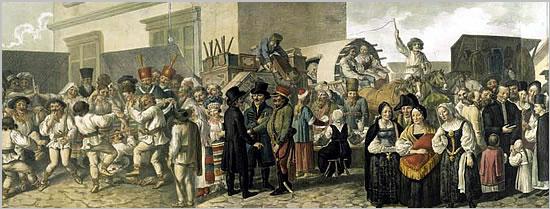

Yet, the Danube “Swabians,” or Donauschwabens, as they were all commonly called, excelled and helped develop the great cities of Hungary. Not only did their farms and villages prosper and grow, the stately classical buildings in Budapest such as the former Royal Palace and Parliament Buildings, the National Theater, the Bourse and the original bridges across the Danube were mainly the creation of Danube Swabian architects and engineers. Furthermore, Hungarian achievements in medicine, science and mathematics included in good part these Germans.
Likewise, the first Transylvanian Germans, the “Sasi,” went to Romania in the 12th Century as colonists from northern Saxony (picture at top). They settled in the central part of Transylvania where they built cities, developed powerful guilds and determined the subsequent economical and cultural evolution of the region. Because they faced savage invasions from the feared Tatars, they protected their towns by strong walls and tall gates. Even their churches became fortresses.
Hermannstadt (Sibiu) in the 12th century was on the trade route through the Olt valley and the site of the Roman city of Caedonia. It was the most important city of the Transylvanian Saxons during the middle ages. The town of Sighisoara was called the “Pearl of Transylvania.” Settled in 1280 by Dominican monks, the city is still surrounded by medieval ramparts, and the winding streets are lined with old buildings. It is one of the seven major Saxon cities that gave Transylvania its German name, Siebenbürgen.
Austria-Hungary was dissolved and the partitioning of Hungary split the Danube Swabian settlements among three mutually antagonistic states. 350,000 became part of “Romania” (who got part of the Banat and Transylvania), 550,000 became the German national minority in a new “Yugoslavia” (who gained land in Southern Hungary, including a strip of the western Banat) and 700,000 remained in Hungary (where the new Czechoslovakia was carved out of former Hungarian territory and historic German areas in the Germanic Sudetenland). Millions of Germans left then because of discriminatory measures put into force within these nationalistic new nations, especially those with business or financial interests which were threatened, but the lifestyle of rural Germans stayed somewhat unchanged until after World War Two when things took a lethal turn. Suddenly, even simple German peasants and farmers were targeted as enemies.